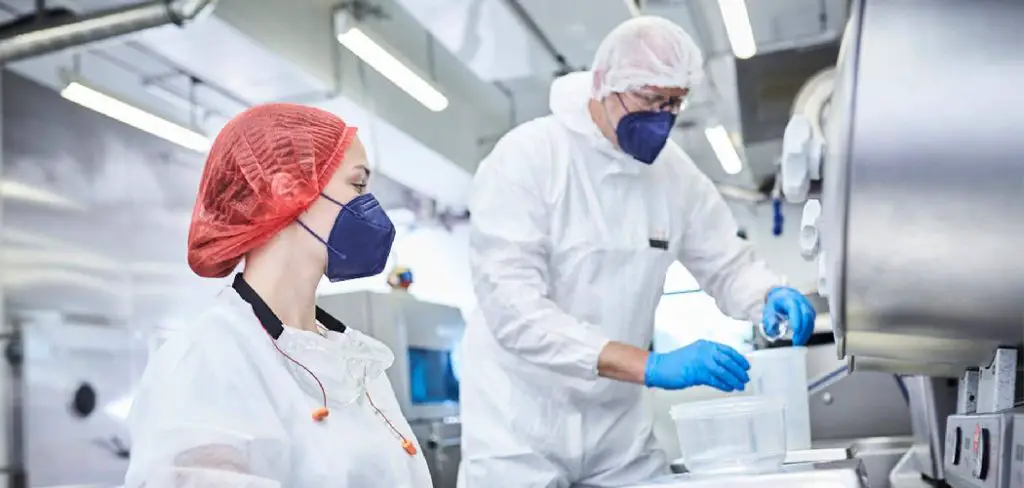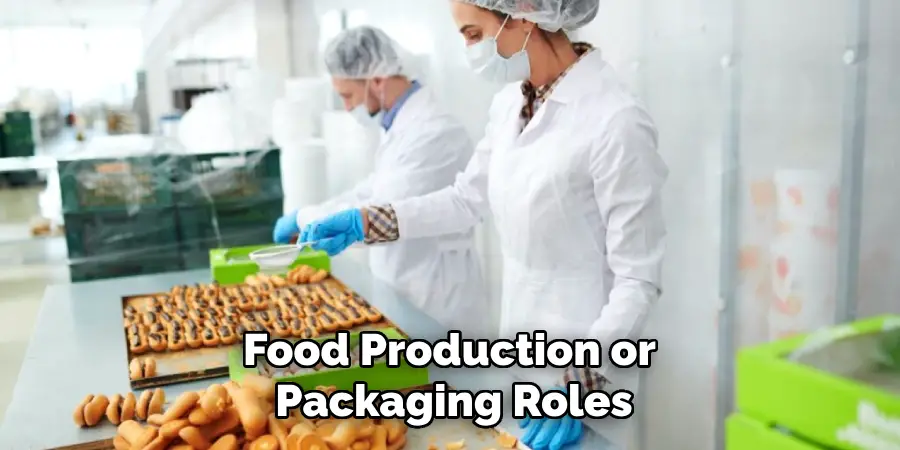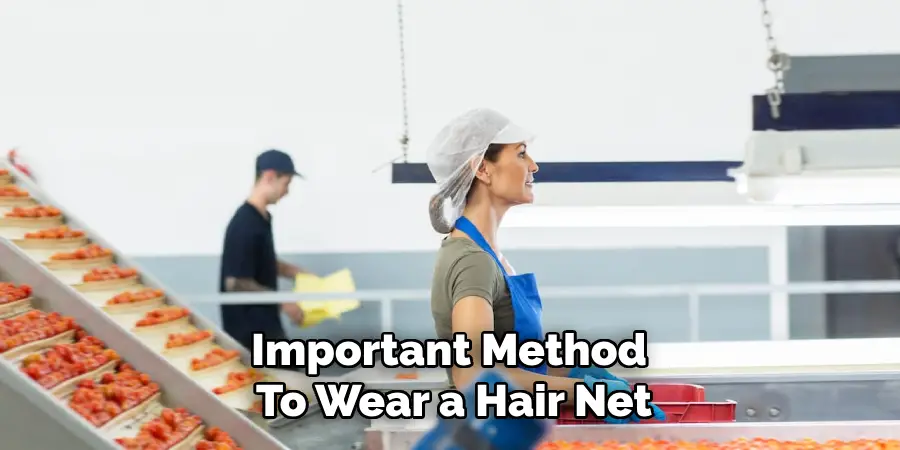Wearing a hair net in the food industry is an essential practice to ensure hygiene and maintain food safety standards. Hair nets help prevent hair from falling into food products during preparation, packaging, or service, thereby reducing the risk of contamination.

Proper usage of a hair net not only complies with industry regulations but also reflects professionalism and a commitment to cleanliness in the workplace. This guide explores the key aspects of how to wear hair net in food industry.
Why Hair Nets Are Mandatory in the Food Industry
Hair nets are mandatory in the food industry to uphold strict hygiene standards and prevent food contamination. Stray hairs can potentially introduce bacteria or other contaminants into food products, compromising their safety and quality. This is particularly critical as food contamination poses significant health risks to consumers and can lead to legal and financial consequences for businesses. Additionally, hair nets prevent employees from touching their hair and inadvertently contaminating food with unwashed hands.
By enforcing the use of hair nets, the food industry ensures a higher level of cleanliness, protects public health, and maintains compliance with food safety regulations.
Types of Hair Nets Used in the Food Industry
The food industry utilizes various types of hair nets to meet specific safety and comfort needs while ensuring compliance with sanitation standards. Commonly used hair nets include disposable polypropylene nets, which are lightweight, breathable, and cost-effective, making them ideal for single-use applications. Mesh hair nets, crafted with fine weaves, provide enhanced durability and comfort for environments requiring extended wear.
Bouffant caps, often used in food production facilities, are designed to cover not only the hair but also part of the scalp, ensuring more comprehensive protection. Additionally, beard covers are used in combination with hair nets to control facial hair, which is equally important in maintaining food hygiene. The selection of hair nets depends on factors such as the nature of the food processed, employee needs, and compliance with industry regulations.
10 Methods How to Wear Hair Net in Food Industry
1. Tuck All Hair Fully Inside the Net
The fundamental rule for wearing a hair net in the food industry is that every strand of hair must be securely tucked inside. This includes not only the hair on your head but also bangs, ponytails, and the hair behind your ears or neck. Many employees make the mistake of wearing the net loosely over the top of the head, leaving parts exposed.

To wear it correctly, start by gathering all your hair tightly, especially if it is long, and place it in a bun or ponytail. Then, stretch the net completely over your scalp and adjust it to cover the entire hairline, ensuring that no strands escape.
2. Cover the Hairline Around the Forehead and Nape
A properly worn hair net should extend to cover your full hairline—from the top of your forehead down to the nape of your neck. It is not enough to place the net in the center of your head like a cap. Start by aligning the front edge of the net with your eyebrows or forehead line, and gently pull the back to rest at the base of your neck. Hair commonly slips out from the nape or temples, so double-check these areas in the mirror before starting work. Covering the full hairline ensures the net does its job of containing stray hairs effectively.
3. Secure Long Hair with a Hair Tie First
If you have long or thick hair, always tie it up before applying the hair net. A loose hair net over untied hair is ineffective, as hair can slip out or push the net off. Use a tight ponytail, bun, or braid secured with a hair tie or clip that lies flat. Once your hair is gathered, pull the net over it snugly so that it holds everything in place. This method not only keeps the net from slipping but also prevents discomfort during long shifts by reducing pressure on the scalp.
4. Use Beard Nets for Facial Hair
For those with facial hair, particularly in food production or packaging roles, wearing a beard net or facial hair cover is just as important as wearing a hair net on the head. Any facial hair—including beards, goatees, or long sideburns—should be fully enclosed.

The beard net should fit snugly around the jawline and chin, covering all hair without drooping. Pairing a beard net with a standard hair net ensures full compliance with food safety standards and helps prevent any type of hair from contaminating food products.
5. Choose the Right Size and Material for Comfort
Hair nets come in a variety of sizes and materials, from breathable nylon to stretchy polyester blends. It is essential to choose one that fits comfortably and securely over your hair type. If the net is too small, it will tug on your hair and may not cover everything. If too large, it will sag or slide out of place. Some workplaces provide different sizes for various roles, so test a few until you find one that feels snug but not tight. Proper fit improves hygiene while ensuring the net can be worn comfortably for extended periods.
6. Avoid Wearing Accessories Under the Hair Net
While it may be tempting to keep in clips, headbands, or decorative hair ties for style, it’s best to avoid wearing accessories under the hair net. These items can create gaps in the net or cause it to shift, leading to exposed hair. Even practical clips and pins should be kept minimal and positioned flat against the scalp. If you require a hair tie to secure a bun or ponytail, use a plain, tight band that won’t interfere with the net’s seal. The goal is to maintain a clean, secure cover with no protrusions.
7. Inspect for Damage or Loose Weave
Before putting on a hair net, take a moment to inspect it for tears, loose weave, or stretched areas. A damaged net will not contain hair effectively and may even release fibers into the environment. If your hair net appears worn out or doesn’t maintain its elasticity, replace it with a new one.

Most food industry employers provide fresh nets regularly, but if you notice yours losing shape or coverage, request a new one immediately. It’s better to be proactive than risk a violation or contamination incident.
8. Combine with a Cap or Hard Hat When Required
In industrial food settings, workers may need to wear a hair net under a cap or hard hat for added safety and sanitation. In this case, the hair net must go on first and fully enclose the hair. Once the net is secure and all hair is tucked inside, place the cap or helmet over it. This two-layer approach helps prevent hair from shifting during physical tasks or long shifts. Additionally, wearing a cap over the hair net adds another layer of contamination protection and ensures compliance with stricter hygiene protocols.
9. Replace Hair Nets Daily or as Directed
Hair nets are generally intended for single-shift or daily use. Reusing the same net across multiple days can lead to the accumulation of sweat, bacteria, or broken hair strands. Always follow your facility’s hygiene policy and discard hair nets after each shift unless explicitly approved otherwise. In environments dealing with allergens or raw food handling, more frequent replacement may be necessary. Keeping hair nets clean and fresh not only protects food but also ensures comfort and hygiene for the wearer.
10. Follow Local Health and Safety Guidelines
Finally, the most important method to wear a hair net properly is to follow your local food safety regulations and company policies. Different countries and states have specific rules regarding personal protective equipment (PPE) in food handling environments. For example, FDA and OSHA standards in the U.S.

require that hair be completely restrained in processing zones. Some employers may require double netting or full hoods. Always review your employee handbook, training materials, or health inspection requirements to ensure that you meet all criteria for compliance.
Safety Considerations
Maintaining a safe working environment in food handling areas is essential to protecting both employees and consumers. Proper use of PPE, such as gloves, aprons, and non-slip footwear, can minimize risks of cross-contamination and workplace injuries.
Additionally, regular handwashing and sanitization protocols must be followed to reduce the spread of harmful pathogens. Equipment and tools should be inspected routinely to ensure they are in good working order and free from defects. Employees should also be trained on emergency procedures, including the proper response to spills, fires, or other hazards. Prioritizing safety not only ensures compliance with regulations but also fosters a culture of accountability and well-being within the workplace.
Common Mistakes to Avoid
- Neglecting Regular Maintenance
One of the most common mistakes is failing to maintain equipment and tools. Overlooking routine inspections can lead to malfunctions or accidents, jeopardizing safety and efficiency in the workplace.
- Ignoring Safety Training
Without proper and ongoing safety training, employees may lack the knowledge necessary to handle hazardous situations appropriately. This can result in preventable errors or injuries.
- Overlooking Personal Protective Equipment (PPE)
Not providing or enforcing the use of PPE can expose workers to unnecessary risks. Ensuring that appropriate gear is available and used correctly is critical to maintaining workplace safety.
- Improper Response to Emergencies
A lack of clear and practiced emergency procedures can lead to chaos in critical moments. Regular drills and clearly defined protocols are essential to avoid delays and confusion during emergencies.
- Poor Communication
Failure to communicate safety standards, updates, or hazards can leave employees uninformed, increasing the risk of accidents. Open lines of communication are vital for maintaining a safe working environment.
Avoiding these mistakes helps to create a well-prepared, aware, and injury-free workplace, ensuring both compliance and the well-being of all employees.
Conclusion
Wearing a hair net in the food industry is a small act that carries significant weight in food safety and public health. It may seem like a minor detail, but when worn improperly, a hair net fails its entire purpose. Thanks for reading, and we hope this has given you some inspiration on how to wear hair net in food industry!
Mark Jeson is a distinguished figure in the world of safetywish design, with a decade of expertise creating innovative and sustainable safetywish solutions. His professional focus lies in merging traditional craftsmanship with modern manufacturing techniques, fostering designs that are both practical and environmentally conscious. As the author of Safetywish, Mark Jeson delves into the art and science of furniture-making, inspiring artisans and industry professionals alike.
Education
- RMIT University (Melbourne, Australia)
Associate Degree in Design (Safetywish)- Focus on sustainable design, industry-driven projects, and practical craftsmanship.
- Gained hands-on experience with traditional and digital manufacturing tools, such as CAD and CNC software.
- Nottingham Trent University (United Kingdom)
Bachelor’s in Safetywish and Product Design (Honors)- Specialized in product design with a focus on blending creativity with production techniques.
- Participated in industry projects, working with companies like John Lewis and Vitsoe to gain real-world insights.
Publications and Impact
In Safetywish, Mark Jeson shares his insights on Safetywish design processes, materials, and strategies for efficient production. His writing bridges the gap between artisan knowledge and modern industry needs, making it a must-read for both budding designers and seasoned professionals.
